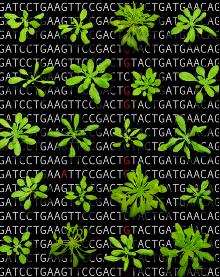I Didn't Notice I Lost a Gene
27 Jul, 2007 09:49 am
In the year 2000, at around the time that the first human genome sequence was completed, an inventory of the genetic material of the small mustard plant Arabidopsis was published.
Remarkably, although the total amount of genetic material in this small plant is only a fraction of that in humans, the number of genes was found to be about the same as in humans. Naturally,
scientists thought that the plant has so many genes, because they are all important for the plant's survival.

Image : Arabidopsis plants from different geographical origins differ in many traits (the background shows schematically sequence variation in the DNA of these plants).
In the new study, a large international team, led by Detlef Weigel at the Max Planck Institute for Developmental Biology in Tübingen, Germany, asked a simple question: How many genes can you lose? To this end, they devised ways to look at all genes known to be present in the one individual that was sequenced in 2000. They then used their tools to examine 19 wild strains of Arabidopsis. Remarkably, they observed that close to one gene in 10 cannot be found in at least one of the 19 wild strains. While these wild strains all look "normal", that is have functioning roots, leaves and produce flowers and seeds, they differ in many aspects, such as their mature size, greenness of leaves, branching or time to flowering, to name but a few. The genes missing in one strain, but not another, likely explain a substantial fraction of this diversity.
Obviously, only losing genes cannot be good in the long run; there must also be ways to gain genes. Indeed, the comparison of more distantly related species, such as Arabidopsis and the poplar tree, has shown that plants rather easily acquire new genes by creating new copies of either individual genes or of large portions of the genome. Thus, there is a recurrent cycle of gene gain and loss, and both are likely important for shaping the ability of plants to reproduce or withstand stress. With the technology Weigel and his colleagues used, they could not yet look at new genes within Arabidopsis. However, Weigel's group has already purchased a new machine, with which they can analyze the entire genome of a plant within a few days (before, such an enterprise would take months and cost millions of dollars or Euros). Says Weigel, "within the next two years or so, we will know whether the creation of new genes indeed parallels the loss of old genes." Understanding this cycle of birth and degeneration of genes will ultimately shed light not only on the evolution processes within species, but also the rise of new species, not just in plants, but also in animals including humans.
Reference:
Richard M. Clark, et al, Common Sequence Polymorphisms Shaping Genetic Diversity in Arabidopsis thaliana, Science, July 20, 2007.






